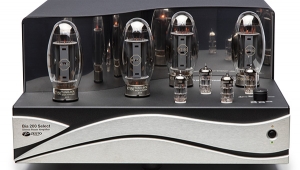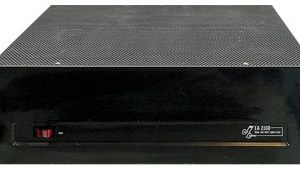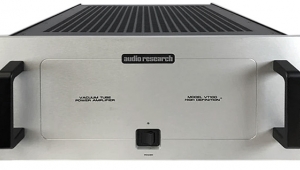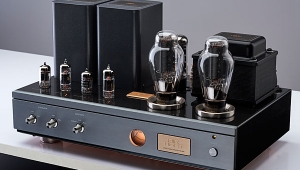| Columns Retired Columns & Blogs |
Lamm ML2.1 monoblock power amplifier Follow-Up, September 2005
Art Dudley wrote again about the Lamm ML2.1 in September 2005 (Vol.28 No.9):
My parents' first house, which they bought three years after I was born, cost $11,000—a factoid I've always been able to cough up at will, no matter how many breakfasts I forget. My parents' second home, which had two floors and a coal-burning furnace, cost $13,000. Some years later I spent $900 on the first car I bought (a Plymouth Duster); many years later I spent a little less than $22,000 on my most recent one (a Subaru Forester). I still have my first guitar amplifier (a 1966 Fender Vibro-Champ, bought as a store demo model for $50 in 1970), and I did, in fact, spend a month's salary on my wife's engagement ring. More or less.
Which leads me to an interesting yet mildly embarrassing bit of news: I've just bought a $29,290 pair of amplifiers.
Keeping current: I'm not paying the full $29,290, of course: Lucky for me, journalists are considered a part of the audio industry, so most manufacturers offer us an industry accommodation price, which is considerably less than what a store would charge.
Still, one of the ways I'm financing my purchase of the Lamm ML2.1 mono amps (I'm buying both of them) is to sell almost all of the other amplifiers I've accumulated over the past few years—another embarrassment. The only one of those I'm keeping is my Fi 2A3 Stereo, which is special.
Which is also why I'm buying the Lamms: As I said in my review of them in the October 2004 Stereophile, they make music like nothing else. In fact, the Lamm ML2.1 is the finest audio amplifier I've heard to date.
This is not to say they've been completely trouble-free. During their tenth month here, the right-channel ML2.1 began making a quiet popping noise through its speaker. Then, after a few minutes of that mischief, it went silent altogether—although the power indicator light continued to glow. The immediate problem was traced to a 1.25-amp internal fuse that had blown, albeit not spectacularly, so I replaced it. Then, assuming that the noise and subsequent fuse failure had been caused by a naughty refrigerator on an adjacent household circuit, I plugged that and the left-channel amp into a different outlet and returned the first unit to active duty on the front line. Then the popping and blowing happened all over again.
The problem turned out to be one of the two 6C33C tubes (the tube marked V2 is this single-ended amplifier's single output tube, while V1 is its regulator). I replaced it, and never had another problem with that particular amp. But I went through all of the above with the other Lamm—the evil, left-hand one, as some religions see it—just a few weeks later.
What gives—or, more to the point, what gave? No one knows for sure, but designer Vladimir Lamm says that the 6C33C tubes used in the ML2.1 usually last at least two to three years—"but sometimes, these things happen..." He offered two bits of very good advice for prolonging the life of my 6C33Cs, the second of which applies to virtually any tube amp:
1) When setting and maintaining the plate current adjustment, remember that 0.31VDC is the maximum—not the center of an allowable range. "If this adjustment is allowed to exceed 0.33," Lamm says, "the tube will not last long. Never exceed that number!"
2) Keep the tubes clean, and avoid handling them with your bare hands—which can transfer skin oils and dirt to the glass envelope. If the glass is allowed to get dirty, heat dissipation goes down, and internal heat builds up to the point where damage can occur. But if you use a liquid of any sort to clean the tubes—a tissue slightly dampened with a very small amount of alcohol is acceptable—you must keep the amp switched off until the surface of the glass is thoroughly dry.
Incidentally, although the ML2.1's otherwise superb owner's manual doesn't mention the fact, Vladimir Lamm recommends that each amplifier's single 6N6P—a uniquely Russian dual-triode tube that's used as an output driver—should be changed once a year. Failing to do so won't harm the ML2.1 in any way, but it will prevent the amp from sounding its best.
The last watt is important, too: I'm sure I haven't even heard my ML2.1s at their best, because my Quad ESL-989 loudspeakers keep them running closer to their last watt than their first, and my more efficient Lowther Medallions tell me what the amps are capable of playing only from the upper bass through the lower treble. And while 90Hz to 12kHz might have passed for "full-range" back in the 1930s, it doesn't cut it anymore. Still...
When I first became enamored of the single-ended triode trend, I thought: One of the best things about this movement is the possibility that any reasonably clever person might be able to build the best amp on earth for a comparatively small amount of money: This needn't be a rich man's thing. I still believe that. But howsoever he's done it, Vladimir Lamm has sidestepped it all, at least for the time being. He obviously knows something that I don't know, and that most other people don't know, about the way electronic devices can be used to play back music, and I'm happy to pay him his due, literally and figuratively, for the work he's done: As it turns out, the things he's figured out are important to me.
And to the few distant family members and scattered old friends who read this magazine I say, "No, I don't have the money I owe you. Obviously."—Art Dudley
- Log in or register to post comments



































